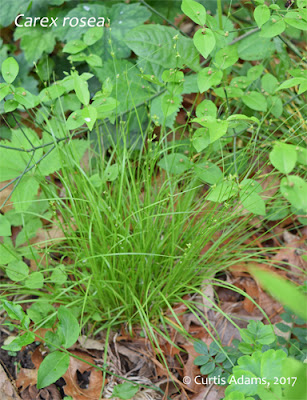On our property in rural Maryland we are blessed with a number of different sedges. Most of these have eluded identification because I have been looking at them in mid-summer when the foliage was big and strong but there were no flowers or seeds in sight. Last fall when I renovated a garden bed I transplanted in several of these 'mystery' sedges. Now, closer to the house I could keep an eye on them and catch them in bloom.
The bloom time for the sedges varies by species and growing conditions. This year they started in early spring and some are still going strong in late May. Some species that bloom early in the season are Pennsylvania sedge (Carex pensylvanica), Appalachian sedge (C. appalachica), and white-tinged sedge (C. albicans). Among the sedges that bloom in mid-spring are rosy sedge (C. rosea) and broad loose-flower sedge (C. laxiflora). Sallow sedge (C. lurida) is one that blooms in early summer.
In the past I have used a book by Lauren Brown, Grasses, an Identification Guide, to try to figure out what I had. This book is nice in that you can get close to an identification without dissecting the plant. However, it is limited in the number of species it covers. This year I used the on-line key at GoBotany developed by the New England Wildflower Society. I was pretty useful but it requires that you have detailed information about the flowers or seeds to make much progress through the key. It also provides links to botanical terms and has good photos of each species when you get to the end. It's limitation is that it only covers species native to the New England states, but that is still an awful lot of plants.
Here are some of the species that I am pretty sure I've identified or confirmed this year:
 |
| Rosy sedge is a reliable shade tolerant sedge. Here its growing in a woodland bed with strawberry bush (Euonymus americanus) and American alumroot (Heuchera americana). |
Rosy Sedge (C. rosea) is one I have been pretty sure about, but I just wanted to confirm. It grows really well in moist shady areas and its mounds of fine textured foliage create a peaceful mood. It's growing along a path that is used by both humans and deer. It can handle a little foot traffic and somewhat compacted soils.
 |
| Broad looseflower sedge name becomes clear when it is allowed to go into flower. Its leaves get wider and the flowing culm flops over as it grows. |
 |
| Here, some smooth sheathed sedge is in flower in open shade. The other grass at ground level is nimblewill (Muhlenbergia schreberi) and a mayapple (Podophyllum peltatum) that was added in, is behind. |
 |
| This group of weak stellate sedge is growing in an upland meadow/woodland edge partly shaded by a mulberry tree and many taller perennials. |
Growing next to the stellate sedge is what appears to be pale sedge (C. pallescens). This one stood out from other nearby sedges because the spikelets are on short stems rather being held tightly to the main stem. This is a more northern species, not too common in Maryland. For that reason I am a little skeptical about this assignment.
An important feature to note when using this identification key is where do the male flowers appear. They can be on a separate spike at the top of the stem, they could be mixed in a spikelet with the female flowers, either above or below, or they could be on separate plants. Another important feature to note is whether the pericarp (where the seed is formed) is divided into sections of two or three.
I often get too wrapped up with trying to name a plant. Sometimes I just need to chill out and enjoy the plants for how they look and how they work in the garden.







No comments:
Post a Comment